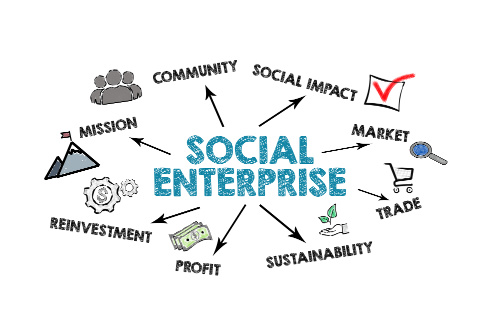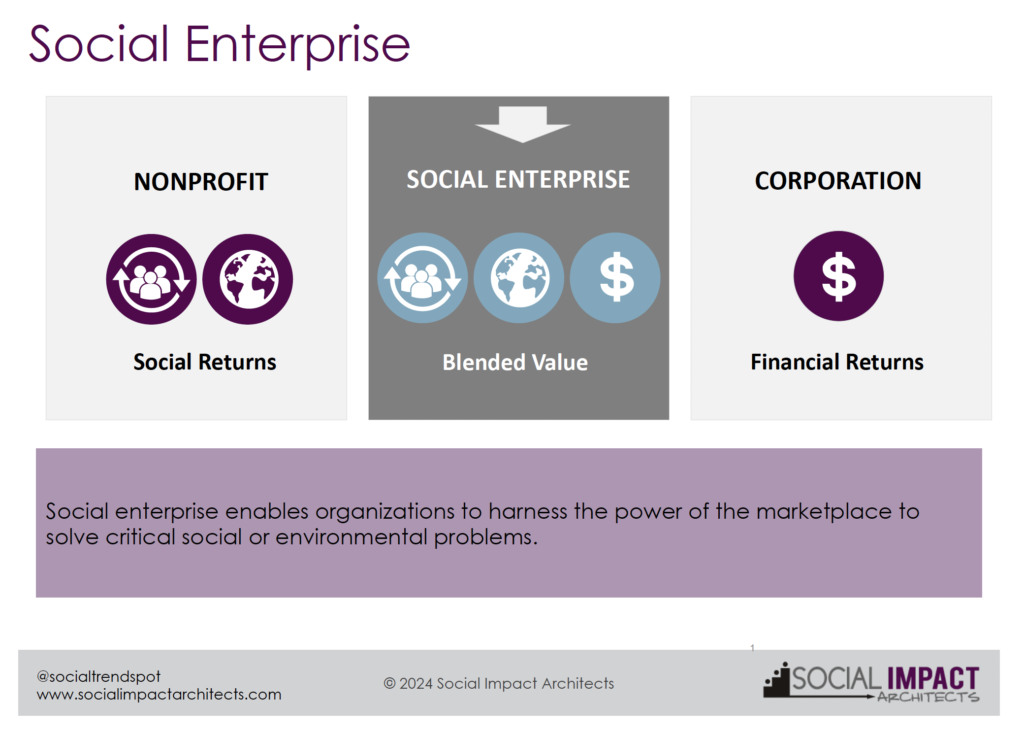
The start of a new year is an excellent time to contemplate new ideas. Based on our latest Megatrends webinar (video + slides coming soon!), one of the top ideas that nonprofits are considering in 2024 is starting (or expanding) a social enterprise (a.k.a., social venture or earned income venture). These ventures enable nonprofit (or for-profit) organizations to harness the power of the marketplace to solve critical social or environmental problems.
Social enterprise has been around for almost a century through the groundbreaking work of pioneers such as YMCA, Goodwill and Girl Scouts. It has recently taken root in the social nomenclature and, based on a recent study we did with Duke, almost 50 percent of all social service agencies have adopted it not only to earn revenue for their organization, but also as a way to advance the social, economic and sometimes environmental goals of the community. Based on these results, social enterprise is not a fad, but instead a paradigm for how many nonprofit organizations are serving their mission as well as earning unrestricted income to support their organization.
As a professor of social entrepreneurship and an entrepreneur, I am often approached by people seeking help with their social enterprise ideas. They often get overwhelmed with how to choose their first venture (or second, for that matter). And, sometimes they jump to the easiest solution – “let’s start a thrift shop or a coffee shop,“ which may not be viable ideas that net a real return for their financial investment and sweat equity. To help, we wanted to share a quick step-by-step process to vet your ideas and turn them into a sustainable social enterprise.
How do you start? Whether you are new to entrepreneurship or starting another venture, you begin the same way:
FIRST, uncover your strengths
Research suggests that the most successful enterprises (for-profit or social) leverage each individual’s or organization’s strengths. Begin with your staff and/or board (or form a social enterprise task force) and brainstorm on a flip chart – what do we have, do or know? We call this process – “ideation.” To do it right, really think broadly (e.g., facilities, intellectual property, subject matter expertise, networks) and without judgment about your unique assets. For example, you may operate a Meals on Wheels program for your local community but only use the kitchen in the afternoons. So, for now, just list the kitchen as something you have that can be leveraged.
SECOND, evaluate your strengths
After you identify your strengths, vote as a group on the top five to seven strengths that are most unique (meaning they are different and distinct from the strengths of others), have value to others (meaning they would be willing to pay for these strengths), and are closest to your mission. To do this, we often use an in-person dot exercise or a Survey Monkey tool. Then, using this handout, walk through the questions below for each top strength and pressure-test it with a rating system. Key questions include:
- Is this strength different and distinct?
- Who would value this strength?
- How valuable is it? Do other options exist?
- What is the willingness and ability to pay for this strength?
- Is this a long-term strength?
NEXT, identify opportunities
After evaluating your top strengths, identify possible opportunities using the same handout. Based on our previous example of the kitchen, you have many opportunities – rent the kitchen to others, start a catering business or provide additional meals.
FINALLY, assess your opportunities
After you identify your opportunities, vote on the top five to eight opportunities (they could all come from one strength or not) and then walk through each question in our handout to assess their promise based on ease of implementation, mission/fit and profit. We have shared another handout to assist you. Key questions include:
- How easy will it be for my organization to implement this opportunity?
- How will this opportunity impact our ability to achieve our mission?
- What is the potential profit that this opportunity will generate for our organization?
Based on our previous example of the kitchen, renting the kitchen may be the easiest to implement, but starting a catering business might be closer to your mission if you serve a hard-to-employ population. By rating each opportunity, you can find which one has the most promise. We often have groups rate individually and then average the rankings to ensure that everyone has a voice. Then, we unveil the ratings to decide which opportunity deserves the most consideration.
Every idea is a good idea, but not every idea is viable. Success requires the right opportunity, the right timing and location, and the right process. Once you determine that all of these are aligned, conduct a feasibility assessment with the final candidate(s). The feasibility assessment allows you to “fail early and cheaply” and helps you decide on a go or no-go decision. If the feasibility assessment is promising, the next step is developing a business plan to create a roadmap for your venture.
Once you go through these steps, you will have the confidence that your venture is not only the best opportunity for you, but also a viable business venture for years to come. If you are considering social enterprise this year, let us know how we can help you.

